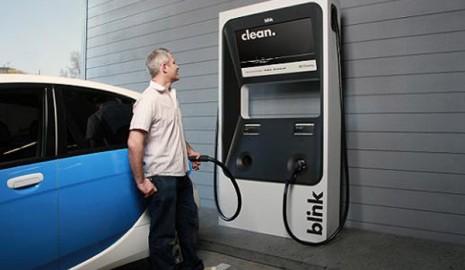This month marks a pinch point and reality check for the massive $2 trillion infrastructure plan that President Biden proposed earlier in the year—especially as he's said a higher gas tax is off the table. It’s starting to look more likely the administration might need to choose between a solution with strong bipartisan support and one that includes the renewable energy components Biden has been asking for.
Amid multiple bills in Congress—some of them essentially surface bills reauthorizing funds before a September 30 cutoff—two heavyweights have taken form in each respective chamber. A House bill proposing an additional $762 billion of funding over an eight-year period. Then there’s a bipartisan group of Senators that has also been working on a version.

Blink EV charging point at IKEA store
It’s the Senate version that’s been setting off alarm bells among green-energy interests, as it reportedly lacks some of the climate action and green-energy aspects that are included in the House version.
Bipartisan push in Senate pulling Biden's EV-focused vision apart?
“The planet cannot survive another successful Republican obstructionist strategy on climate action,” stated Massachusetts Senator Ed Markey earlier this month, with a group of at least eight Senators emerging to say that they wouldn’t support a bill lacking climate policy. “It’s simple: no climate, no deal,” Markey summed.
"The Democrats’ agenda on climate change is probably something they're going to pursue by and large outside of an infrastructure bill," said Senator Mitt Romney, who was part of the bipartisan group—indicating that the group might not be envisioning anything akin to Biden’s proposal to interweave green jobs, energy policy, and roads, highways, manufacturing and the supply chain.

Solar panels on a Walmart store
As recent Pew polls suggest, a strong majority of Americans support more renewable energy and do see EVs as better for the environment. Since the Obama-era Clean Power Plan there has not been a coordinated federal approach for curtailing power generation emissions, although EPA chief Michael Regan said earlier this year the Biden administration seeks a “fresh” approach.
Pressure built last week as a number of environmental groups became more vocal. The Natural Resources Defense Council (NRDC) on Thursday reiterated the "no climate, no deal" mantra and noted the importance of climate provisions in supporting other aspects of the plan.
The Biden plan faced some earlier criticism about its EV-related spending. It would technically spend just $15 billion on charging stations, with the bulk of the proposed $174 billion of EV spending going to consumer rebates and boosting domestic manufacturing and the supply chain.
Hurdles of higher spending
Options for helping fund the higher spending are limited. Senate Finance Committee Chairman Ron Wyden reportedly seeks to phase out a deduction for high earners that was introduced with 2017 tax changes. Both the House and Senate proposals attempt to accomplish Biden’s wider vision of infrastructure without raising taxes on those making less than $400,000 a year—although the Senate version reportedly includes a user fee for EV drivers (something unlikely to pass muster with Biden).

Gas pump
In January Transportation Secretary Pete Buttigieg said that options for paying for highway and infrastructure improvements wouldn’t involve a gas tax increase but needed to have other options to preserve “that user-pays principle.” In May, Buttigieg said a vehicle-miles-traveled tax “shows a lot of promise” as a funding stream, but it was later clarified that was a general statement and not related to the infrastructure plan.
The federal gas tax remains 18.4 cents per gallon, and it hasn’t been raised since 1993, and that’s required some topping-off of the Highway Trust Fund over the years, as a stopgap measure.
Boosting the gas tax is actually something former President Trump favored. In 2018, with the announcement of a $200 billion infrastructure spending plan, he pushed a 25-cent-per-gallon increase. That drew strong opposition from his own party in Congress.













